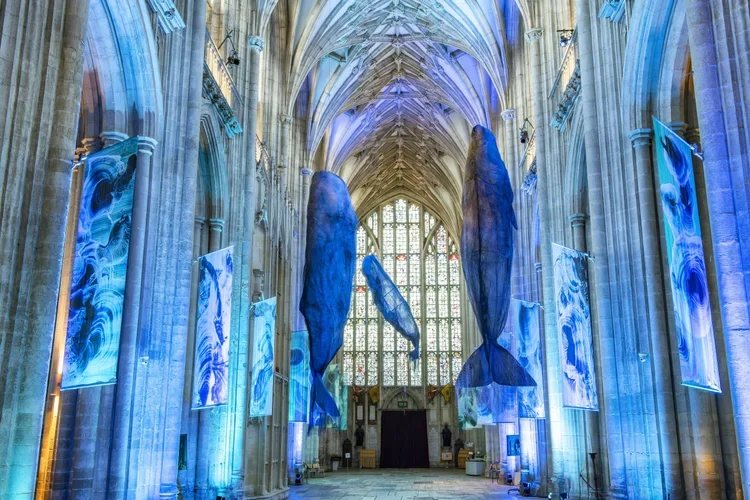Inside Canterbury's very own Medieval Fight Club
Latex maces & crushing collarbones - Columnist Sam Wood heads to a Medieval Combat Club
We’re all looking to sate that inner-knight. Canterbury Medieval Combat is our solution; prescribing training in longsword, dagger, poleaxe, sword and buckler, spear, judicial fighting shields and occasionally lightsabres.
There is a collection of sounds uncommon in the rest of Canterbury, emanating from St Dunstan’s Church Hall, at the upper end of the city.
There are steely clashes as German longswords meet, pleasing thuds of wooden spears colliding, the rare “Ow” and the very regular bouts of laughter as 12 people in the hall enjoy their hobby. This is medieval combat.
Stepping into the hall I was first struck, not by a latex mace, but by the breadth of characters taking part. I’d expected everyone to look dangerous, and though it’s hard not to when wielding a 4-foot longsword, I instead met friendly faces comparing views, jokes, and their latest bruises.
At the centre of the hall’s amicable fray is the leader of the club, Jason Hulott. Overtly approachable, yet capable of a disarming you in many ways, either with a large piece of metal or with a joke, he welcomed me into the group – mainly made up of other first-timers on this occasion.
And first-timers are common, as HEMA (Historical European Martial Arts) has seen a boom in recent years, thanks to improvements in blacksmith services across Europe, as well as Tom Hardy’s famous participation at a recent regional event… and experts like Jason bringing people together.
Others consider this evening’s session as practice for upcoming HEMA events taking place across the UK - it’s a chance to compete, socialise, and test their latest armoury purchases.
As Jason introduced the lesson, it became evident how long he’s been doing this. Having led this club for nearly a decade now, with more than 30 years in martial arts in total, his expertise is sought by museums, academics, and enthusiasts across the country, and many are drawn to his offer of a fun discipline with swords.
“On our first night, 42 people showed up!” Jason reveals. “They come from many backgrounds, so we’re a very broad church.”
Electrician Greg well-exemplifies this. Standing at 6’7’, he passes me three swords and a warm smile before he says a word. He then hands me a spear. Then a mace.
Greg is only attending in a partial capacity today on account of a having “torn something, probably” in his chest.
“It happened at the latest competition; ‘Le Weekend’ in Sandwich”, Greg tells me, his Polish accent coming to the fore. Both full armoured, his opponent had rolled on top of him – something of concern mid-bout for Greg – who is not long recovering from a deflated lung.
Expecting his lung having become floppy due to the bouts, Greg corrected me.
That incident, in addition to a number of scars he takes time to show me, are perhaps surprisingly nothing to do with medieval combat.
“I think someone a few years ago lost an eye, but the accidents are very few and far between in reality. The armour sees to that and, of course, all weapons are blunted or rolled (tips).”
Greg demonstrates his last point by pinging the end of a spear-tip with his finger, making it wobble.
Greg became involved in the club when it was based in Broadstairs, after initially taking-up combat archery in Copenhagen and wanting to pursue something “nerdy but physical”.
“I had no real expectations of what this club would become,” explains Jason, “but it shows how much swordplay is present in our culture today”.
Live Action Role-players, historical re-enactors, academics, film and TV buffs are the typical students of this and similar clubs, as well as actors and stuntmen – many looking to get an accurate representation to display on film/TV.
Jason’s ranks feature a fair few professionals, too, past and present, including pharmacists, opticians, designers, students, former soldiers, paramedics, and doctors. This church is indeed broad.
No one starts armoured, until the practice of Jason’s cutting motions are taken-up in pairs, at which point gloves and masks are adorned by those who remembered to bring theirs from home.
One half of the room became ‘Meisters’ and the other ‘Buffel’ (meaning between ‘peasant’ and ‘buffalo’). I was a buffalo, but I’ve never seen someone be as considerate to a cow as my partner was to me.
The sounds of clashing metal (or synthetic rubber blades for beginners) are interspaced by the chatter of people helping each other. “Higher – you really want to crush my collarbone”, says my partner.
But there is a quieter side to HEMA. Jason explained: “For some it’s the sports-side, hitting people and scoring points and winning medals. For others it might be about looking at the manuscripts and trying out why techniques work in a particular way. Combined, these things focus our brains and minds – which is a consequence of hitting each other with weapons.”
Historical context is key to the club. For example, in German Longsword training movements are dictated by the likely presence of open sewage in the streets as per the times. This realism is why so many attend.
In-between training sessions, the club reviews manuscripts and manuals, from Bartitsu – a Victorian discipline (likely the first Mixed Martial Art) - to WW1 Trench Warfare. The community splits off to do different things in different ways – but the club remains a centre.
“There’s a huge amount going on, it’s a vibrant space: there’s just not enough hours in the day to do it all,” says Jason.
For those looking to get started though, it’s 7-9pm, Mondays and Thursdays at St Dunstan’s Church Hall, Canterbury. Everyone’s welcome. Swords are provided.












